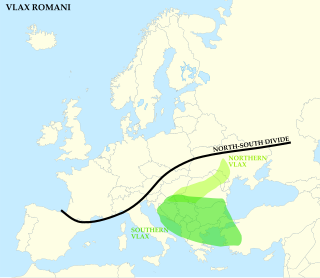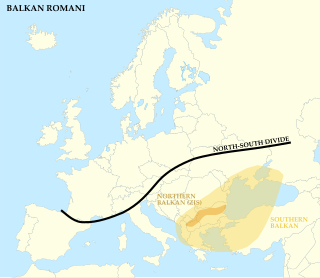
Macedonian is an Eastern South Slavic language. It is part of the Indo-European language family, and is one of the Slavic languages, which are part of a larger Balto-Slavic branch. Spoken as a first language by around two million people, it serves as the official language of North Macedonia. Most speakers can be found in the country and its diaspora, with a smaller number of speakers throughout the transnational region of Macedonia. Macedonian is also a recognized minority language in parts of Albania, Bosnia and Herzegovina, Romania, and Serbia and it is spoken by emigrant communities predominantly in Australia, Canada and the United States.

The Romani, also spelled Romany or Rromani and colloquially known as the Roma, are an ethnic group of Indo-Aryan origin who traditionally lived a nomadic, itinerant lifestyle. Linguistic and genetic evidence suggests that the Romani originated in the Indian subcontinent, in particular the region of present-day Rajasthan. Their subsequent westward migration, possibly in waves, is now believed by historians to have occurred around 1000 CE. Their original name is from the Sanskrit word डोम, doma and means a member of the Dom caste of travelling musicians and dancers. The Roma population moved west into the Persian Ghaznavid Empire and later into the Byzantine Empire. The Roma are thought to have arrived in Europe around the 13th to 14th century. Although they are widely dispersed, their most concentrated populations are located in Bulgaria, Hungary, Romania, Spain, and Turkey.
Romani is an Indo-Aryan macrolanguage of the Romani communities. According to Ethnologue, seven varieties of Romani are divergent enough to be considered languages of their own. The largest of these are Vlax Romani, Balkan Romani (600,000), and Sinte Romani (300,000). Some Romani communities speak mixed languages based on the surrounding language with retained Romani-derived vocabulary – these are known by linguists as Para-Romani varieties, rather than dialects of the Romani language itself.

The Sinti are a subgroup of Romani people. They are found mostly in Germany, France and Italy and Central Europe, numbering some 200,000 people. They were traditionally itinerant, but today only a small percentage of Sinti remain unsettled. In earlier times, they frequently lived on the outskirts of communities.
The Dom are descendants of the Dom caste with origins in the Indian subcontinent which through ancient migrations are found scattered across the Middle East and North Africa, the Eastern Anatolia Region, and parts of the Balkans and Hungary. The traditional language of the Dom is Domari, an endangered Indo-Aryan language, thereby making the Dom an Indo-Aryan ethnic group.

The Balkan sprachbund or Balkan language area is an ensemble of areal features—similarities in grammar, syntax, vocabulary and phonology—among the languages of the Balkans. Several features are found across these languages though not all apply to every single language. The Balkan sprachbund is a prominent example of the sprachbund concept.

Vlax Romani is a dialect group of the Romani language. Vlax Romani varieties are spoken mainly in Southeastern Europe by the Romani people. Vlax Romani can also be referred to as an independent language or as one dialect of the Romani language. Vlax Romani is the second most widely spoken dialect subgroup of the Romani language worldwide, after Balkan Romani.
The Romani language has for most of its history been an entirely oral language, with no written form in common use. Although the first example of written Romani dates from 1542, it is not until the twentieth century that vernacular writing by native Romani people arose.

Domari is an endangered Indo-Aryan language, spoken by Dom people scattered across the Middle East and North Africa. The language is reported to be spoken as far north as Azerbaijan and as far south as central Sudan, in Turkey, Iran, Iraq, Israel, Palestine, Jordan, Egypt, Sudan, Libya, Tunisia, Algeria, Morocco, Syria and Lebanon. Based on the systematicity of sound changes, it is known with a fair degree of certainty that the names Domari and Romani derive from the Indo-Aryan word ḍom. Although they are both Central Indo-Aryan languages, Domari and Romani do not derive from the same immediate ancestor. The Arabs referred to them as Nawar as they were a nomadic people that originally immigrated to the Middle East from the Indian subcontinent.

The Romani people are a distinct ethnic and cultural group of peoples living all across the globe, who share a family of languages and sometimes a traditional nomadic mode of life. Though their exact origins are unclear, central India is a notable point of origin. Their language shares a common origin with, and is similar to, modern-day Gujarati and Rajasthani, borrowing loan words from other languages as they migrated from India. In Europe, even though their culture has been victimized by other cultures, they have still found a way to maintain their heritage and society. Indian elements in Romani culture are almost non-existent, with the exception of their language. Romani culture focuses heavily on family. The Roma traditionally live according to relatively strict moral codes. The ethnic culture of the Romani people who live in central, eastern and southeastern European countries developed through a long, complex process of continuous active interaction with the culture of their surrounding European population.
Baltic Romani is group of dialects of the Romani language spoken in the Baltic states and adjoining regions of Poland and Russia. Half of the speakers live in Poland. It also called Balt Romani, Balt Slavic Romani, Baltic Slavic Romani, and Roma. Romani began as an Indo-European language, which morphed into an Indo-Iranian language, and then into an Indo-Aryan language. After that the Romani language broke down into Balkan Romani and Central Romani. Baltic Romani came from the Central Romani dialect which branches off into other dialects. There are a total of around 31,500 users in all countries.

The official language of North Macedonia is Macedonian, while Albanian has co-official status. Macedonian is spoken by roughly two-thirds of the population natively, and as a second language by much of the rest of the population. Albanian is the largest minority language. There are a further five national minority languages: Turkish, Romani, Serbian, Bosnian, and Aromanian. The Macedonian Sign Language is the country's official sign language.
The Romani people of Greece, or Romá, are called Tsinganoi, Athinganoi (Αθίγγανοι), or the more derogatory term Gyftoi. On 8 April 2019, the Greek government stated that the number of Greek Roma citizens in Greece is around 110,000. Other estimates have placed the number of Romani people resident in Greece as high as 350,000.

Romani people in North Macedonia are one of the constitutional peoples of the country.
Para-Romani are various mixed languages of non-Indo-Aryan linguistic classification containing considerable admixture from the Romani language. They are spoken as the traditional vernacular of Romani communities, either in place of, or alongside, varieties of the Romani language. Some Para-Romani languages have no structural features of Romani at all, taking only the vocabulary from Romani.
Sinte Romani is the variety of Romani spoken by the Sinti people in Germany, France, Austria, Belgium, the Netherlands, some parts of Northern Italy and other adjacent regions. Sinte Romani is characterized by significant German influence and is not mutually intelligible with other forms of Romani. The language is written in the Latin script.
The Eastern South Slavic dialects form the eastern subgroup of the South Slavic languages. They are spoken mostly in Bulgaria and North Macedonia, and adjacent areas in the neighbouring countries. They form the so-called Balkan Slavic linguistic area, which encompasses the southeastern part of the dialect continuum of South Slavic.
The sedentary Arlije are the main group of the Romani people in North Macedonia, and the majority live in Šuto Orizari Municipality. They are Muslim Romani. There are various subgroups of the Arlije, named after their traditional occupations, living in North Macedonia, Kosovo, and southern Southern Serbia, and Montenegro. Beside Macedonian and Albanian, they speak the Arli dialect of Balkan Romani. The word Arlije is derived from the Turkish word yerli, as does the name Erlides (Greek: Ερλίδες, of a similar group living in Greece, and the Sofia-Erli in Bulgaria. The biggest settlement of Arlije is in Šuto Orizari in North Macedonia. In East Thrace at Turkey, they are called Yerli Romanlar and only speak Rumelian Turkish.

Rumelian Romani is a dialect of Southern Romani of strong Turkish pronunciation with Turkish and Greek loanwords, once was spoken by the Turkish-Muslim Roma (Xoraxane) in Ottoman Rumelia, especially by the Sedentary Rumelian Romani people of various groups in Edirne in East Thrace First described by Evliya Çelebi's Seyahatname in 1668, of the Muslim Roma in Gümülcine, and later by William Marsden in 1785 and by Alexandros Georgios Paspatis (Paspati), a scholar of the Romani language in 1870. The Greek Doctor A. G. Paspati made also the statemant in his Book, that Turks married often Roma Woman. This Romani dialect is almost extinct in Turkey, but still spoken by Muslim Roma in Western Thrace today.
Early Romani is the latest common predecessor of all forms of the Romani language. It was spoken before the Roma people dispersed throughout Europe. It is not directly attested, but rather reconstructed on the basis of shared features of existing Romani varieties. Early Romani is thought to have been spoken in the Byzantine Empire between the 9th-10th and 13th-14th centuries.










